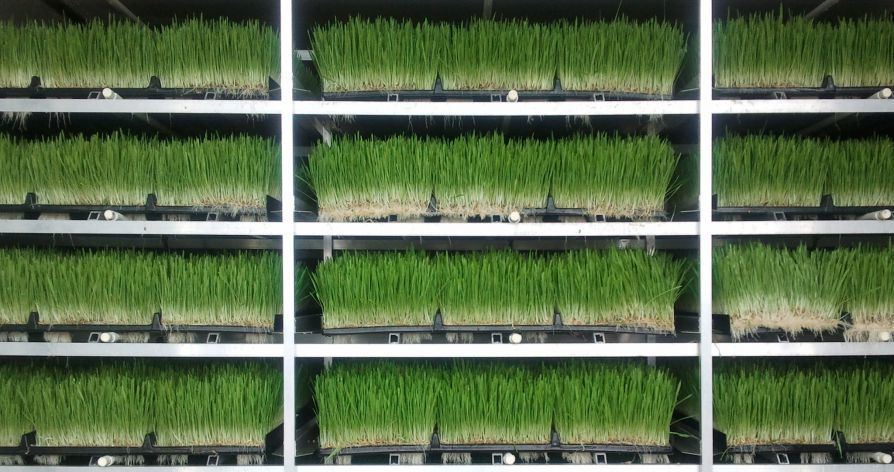A robotic vertical farm grows plants 400% more efficient than a regular farm.

The population of the Earth is constantly growing, respectively, increases the need for food. This has been talked about for many years, and some scientists believe that soon the planet will not be able to feed all the people. Other experts argue that there is no problem with food for people, it is only necessary to develop new ways of cultivating plants in order to get more biomass per unit of time. Moreover, plants are needed not only for people, but also for animals that people grow for their own needs, especially for cattle.
One of the most promising ways to achieve the desired - the creation of vertical farms . Multi-storey racks or even buildings with plants on each tier make it possible to obtain a green product in large quantities even within the city. Here come the help of high technology. For example, the agricultural company FodderWorks has developed a completely autonomous system that is able to work without the participation of people, working much more efficiently than a human farmer.
In any case, for a unit of time, this vertical robot farm grows 400% more biomass than a human being. Its dignity is not only in the speed of work but also in the fact that it practically does not use fertile soils, and also consumes quite a bit of water compared to conventional agricultural land.
')
“Such a system is compatible with any cereal. But it can also be used to cultivate any other plants that can be eaten both by people and animals, ” say the authors of the idea.
The growing process is quite simple. Seeds are placed in special boxes, which are installed on the shelves. Here they begin to light up and give water with nutrients. After six days, the seeds germinate, forming dense green "mats". This biomass can be used as a feed for cattle. And neither fertilizers, nor toxic chemicals are required. And the cost of biomass with this method of operation is about 15 cents per kilogram (6 cents per pound). A big plus feed is that it is not dry hay, but a complete plant, which is much more useful for animals than hay. It must be thought that the horned pet farms juicy fresh greens will have more to taste than dry grass. Although, how do we, the people, know about it.
Green fodder for livestock of this type is not new, it has been used for a long time. The problem is that workers are usually needed to take care of the system, since this is a manual job. If you hire a lot of people - the cost of feed will be high. If the farm staff is small, you will not be able to grow the amount of feed needed for animals. But if the system is automated, these problems can be avoided. This is why the developers at FodderWorks decided to create their own system.
It can be a salvation for small farmers, those who cannot afford employees to expand their work and increase food production. According to representatives of FodderWorks, now "our partners can afford to be effective, independently running their business, which can be an incentive for creating more jobs in the agricultural sector."
The robotic farm in question, she herself falls asleep grain in boxes, she exposes the necessary diet and lighting. After six days, the robot farm collects the resulting product and packs it. Man is needed only to give grown food to livestock. In principle, it is possible to automate this as well, which is successfully used by many agricultural enterprises.
The cost of one robo farm capable of growing a ton of plants per day is $ 233,000. A system with a capacity of 12 tons of plants per day is $ 996,000, that is, the cost per ton is less than that of a small robo farm.
Automation of food production is not new. This problem is addressed by both private companies and scientific organizations. Not so long ago on Geektimes the aquaponic farm Verticulture was described, which enables the simultaneous production of fish (tilapia) and plants (basilica). To date, Verticulture farm is a system of tanks with water and racks up to 3 meters high. Tilapia lives in tanks, and basil crates are communicated by means of pipes with tanks of fish. Capacities with bacterial culture are located between them, where fish waste is processed into nitrate fertilizer. The roots of plants receive nutrients, and the water is purified from salts, returning to the fish already purified.
In such a system, almost 100% of water is reused; for lighting, only economical fluorescent lamps are needed. The constant participation of people in the work of the aqua farm is also not required - most of the processes are debugged and automated.
Source: https://habr.com/ru/post/402619/
All Articles